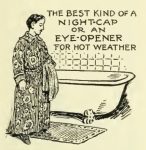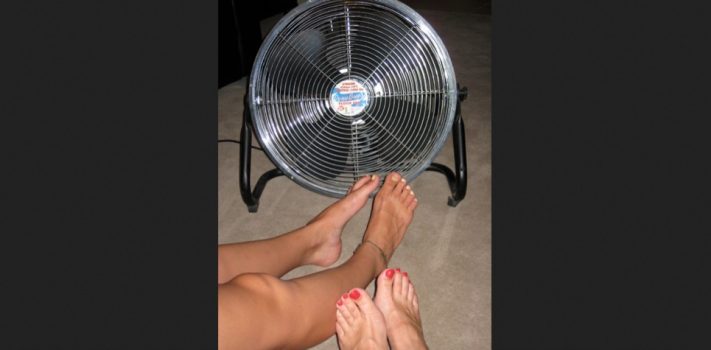Every heat wave kills people. For most of us, it’s a minor inconvenience and hurts our wallets more than anything else. Here in the US, air conditioning is now almost ubiquitous and everything is fine. But what about when grid power is not available?
This article is aimed at people living in cities and suburbs who find themselves without power during a heat wave. For whatever reason there is no power for some time, what do you do? It also applies to people who just can’t afford air conditioning which is where I learned a lot of these things.
As a student, I lived in a tiny attic apartment in a big city. I simply could not afford air conditioning. I’m not being melodramatic, I later found out that I qualified for food stamps even as I was studying and teaching full time. So my wife and I got to learn how to deal with miserable city heat. Before that, I had spent years in the Southeast United States again without air conditioning for reasons out of my control. And now I live in the upper midwest without air conditioning. Now in this situation I could get air conditioning but it’s only miserable for a couple of weeks each year, and by now I have experience dealing with the heat.
A lot of the guides I see floating around about dealing with the heat are very surface level and wouldn’t have helped me in dealing with oppressive heat. So what I’m going to give you are two parts: strategies I’ve used and know work and strategies I would pursue if I had to swelter again.
Use Water (And Possibly A Battery Powered Fan)
When we say “cool down” what we really mean is “move heat away from of our bodies”. This is Thermodynamics for the engineering inclined among us. How do you move heat out? For humans, water is the cheapest and most accessible way. Air can and does move heat but air insulates more readily than it moves heat. That’s part of why air conditioning is such an energy hog, it’s not a very efficient method of moving heat away from human bodies, we’re brute forcing it. Ask yourself: “Which will cool you faster? 5 minutes in a cold shower or 5 minutes in air conditioning?” Air conditioning is a more comfortable method but the shower is more effective.
So we use water and water with air to cool our bodies directly. The water itself is cooling and we can add more cooling with evaporative cooling (flowing air over the wet skin). This evaporative cooling with water works even when the humidity is nasty and your sweat just sits on your skin. These two ways of moving heat are why going to the pool (or swimming hole) is such a time-honored strategy. The best way to use water is to have the water flow over you. Flowing water transfers heat very effectively so a lukewarm or cold shower is your best bet for quickly cooling.
 In the attic apartment, taking 2 AM showers would have disturbed our neighbors so instead we filled the bathtub with cold water in the early evening and left it. When we got too hot my wife or I would submerge ourselves in that cold water and then stand in front of a fan. Together the cold water and fan would give us cooling when a fan by itself would not give us any relief. It was a really bad night when we had to refill the tub because the water became warm.
In the attic apartment, taking 2 AM showers would have disturbed our neighbors so instead we filled the bathtub with cold water in the early evening and left it. When we got too hot my wife or I would submerge ourselves in that cold water and then stand in front of a fan. Together the cold water and fan would give us cooling when a fan by itself would not give us any relief. It was a really bad night when we had to refill the tub because the water became warm.
Remember that as long as the water is below 97F, submerging yourself in it will move heat away from your body. Wearing a swimsuit or equivalent and having the cooling area with an absorbent mat is useful here as you won’t want to dry off with a towel. You want to be blown dry while you are still dripping. A cooling station in the bathroom will help.
If it’s not bad enough to need a cold bath or cold shower but your sweat isn’t helping, then I recommend spreading cold water on your skin with a wet cloth and then exposing that skin to moving air. This isn’t as effective but sometimes is just the right amount of cooling. I will often do this just before bed on a hot night. A lukewarm rather than cold shower is also a possibility.
“But…”, I hear you say: “…fans are electrically-powered”. True. You will want a (or a couple) battery-powered fans if you would have to deal with high heat and no grid power. Not the ones the size of a remote control, a serious one. The heat here isn’t bad enough to make me buy but I would look at the ones that are part of battery-powered tool families. These are sometimes called “jobsite fans” and if you already have battery power tools, that’s a quick and easy thing to grab. Pull the battery from your cordless drill and plop it in the fan. The other search term is “camping fan” though “glamping fan” would be a better description. Whichever route makes sense for you, a battery-powered fan used directly on you to cool is worthwhile.
Keep in mind that a fan idly running isn’t useful. If the fan isn’t actually cooling you, go, use water and make the fan useful. A fan blowing over you while you sleep may or may not be indicated, it depends how much power you have on hand and how much relief it brings. A fan drying off a large area of your skin is cooling even in miserable humidity. In low humidity it’s even more useful.
Get the cool air
There are two main ways to get cool air: 1. Try to trap cooler air inside before the outside heats up. 2. Vent the hotter air out when the living area is hotter than the outside. Here is a simple rule to get this: close the house while it’s still cool and open as soon as you can’t tell which is cooler.
Our attic apartment had no cross breeze available since all our windows were on the same side of the house. We opened windows and tried to get cool air in when there was cooler air but in a big city, the heat doesn’t really break. You’re living in a giant heat sink. Thousands (or millions) of tons of concrete and steel soak up heat all day long and release it again at night. Then all the air conditioning units of your thousands (or millions) of neighbors are dumping their heat into that heat sink. If you’re lucky you’ll get some cooler air right before dawn.
When I lived in the suburbs of the South East without air conditioning this strategy was much more effective and it works where I live now in the upper midwest. Cross breezes are ideal because moving air also gives you some direct cooling. Without that option I used window fans to move the hotter air out, it kind of works.
This is a good strategy that sometimes works. It’s highly dependent on your specific location. If you can get hot air out, do it. Close up the house before the heat hits and to do that you want to be ahead of the heat. You don’t want to wonder whether it’s getting hot, you want it closed up while it’s clearly still the morning cool. I want the windows all shut at or before 9 AM as a rule but it’ll depend. As I write this, the temperatures are supposed to hit the 90s really late in the day but at the moment letting the breeze move through is better than shutting up the house even though it’s after 10 AM. I’ll close it up shortly and I’ll open up again as soon as I’m unsure if it’s hotter inside or outside the house.
Bed Down Where It’s Coolest
Determine where the coolest place is in your space and sleep there. Heat robs you of sleep and that makes everything worse. When I was in the southeast I used to take a pillow and sheet and sleep on the floor in the ground level. In the attic apartment we just slept in the coolest area we could find.
Summer sleeping arrangements may well be different. There’s a reason cabins in the 50s had screened porches, that let you catch any breeze and kept you low. Similarly, I’ve read accounts of city dwellers sleeping on the fire escapes to try to get some relief in the days before air conditioning. Sleep where it’s cool.
Related to this: If you can avoid being upstairs then avoid it. There is a measurable difference between being on the third floor and being on the ground floor.
(To be concluded tomorrow, in Part 2.)










